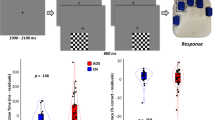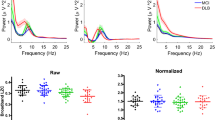Abstract
Background
Parkinson’s disease (PD) and dementia with Lewy bodies (DLB) share pathological and clinical similarities while differing in the timing and severity of motor cognitive and visual impairment. Previous EEG studies found abnormal neural oscillations in PD, mild cognitive impairment (MCI) and Alzheimer’s disease, however, the electrophysiological signature of clinical symptoms is still unclear. We assessed the specificity of event-related oscillations in distinguishing between cognitive, motor and visual involvement in patients with neurodegenerative conditions.
Methods
EEG was recorded during a visual oddball task in 30 PD, 28 DLB, 30 MCI patients and 32 age-matched healthy controls. Target and non-target event-related power were examined in the time–frequency domain using complex Morlet wavelet convolution and compared within and between the study groups.
Results
MCI (z = − 1.8, p = 0.04, Cohen’s d = − 0.5) and DLB (z = − 3.1, p < 0.001, d = − 1.0) patients showed decreased delta-band target event-related synchronization compared to participants with normal cognition. PD (z = 1.6, p = 0.05, d = 0.5) and DLB (z = 2.7, p < 0.01, d = 0.9) patients showed decreased beta suppression compared to MCI patients and controls. DLB patients with visual hallucinations (VH) showed decreased early-alpha suppression (z = 2.08, p = 0.019, d = 3.19, AUC = 1.0 ± 0.0) compared to DLB-VH−.
Conclusions
Decreased event-related delta-band synchronization, reflecting a decline in information processing ability, was characteristic of cognitive impairment due to any cause. Decreased event-related beta suppression, reflecting impaired execution of motor action, was specific to PD and DLB. Decreased event-related early-alpha suppression was characteristic of the presence of VH in DLB. These findings show that specific oscillations may reflect specific clinical symptoms, being a marker of network dysfunction.





Similar content being viewed by others
Data availability
Anonymized data can be obtained by request from a qualified investigator for purposes of replicating procedures and results.
Abbreviations
- AD:
-
Alzheimer’s disease
- AUC:
-
Area under the ROC
- DLB:
-
Dementia with Lewy bodies
- ERP:
-
Event-related potential
- MDS:
-
Movement disorders society
- MCI:
-
Mild cognitive impairment
- MoCA:
-
Montreal cognitive assessment
- PD:
-
Parkinson’s disease
- PDD:
-
Parkinson’s disease dementia
- ROC:
-
Receiver operating characteristic
- UPDRS:
-
Unified PD rating scale motor part III
References
Walker Z, Possin KL, Boeve BF, Aarsland D (2015) Lewy body dementias. Lancet 386(10004):1683–1697. https://doi.org/10.1016/S0140-6736(15)00462-6
McKeith IG, Boeve BF, Dickson DW et al (2017) Diagnosis and management of dementia with Lewy bodies: fourth consensus report of the DLB Consortium. Neurology 89:88–100. https://doi.org/10.1212/WNL.0000000000004058
Aarsland D, Creese B, Politis M, Chaudhuri KR, Weintraub D, Ballard C (2017) Cognitive decline in Parkinson disease. Nat Rev Neurol 13(4):217–231. https://doi.org/10.1038/nrneurol.2017.27
Pigott K, Rick J, Xie SX et al (2015) Longitudinal study of normal cognition in Parkinson disease. Neurology 85(15):1276–1282. https://doi.org/10.1212/WNL.0000000000002001
Williams-Gray CH, Mason SL, Evans JR et al (2013) The CamPaIGN study of PD: 10-year outlook in an incident population-based cohort. J Neurol Neurosurg Psych 84(11):1258–1264. https://doi.org/10.1136/jnnp-2013-305277
O’Hara DM, Pawar G, Kalia SK, Kalia LV (2020) LRRK2 and α-Synuclein: distinct or synergistic players in PD? Front Neurosci. https://doi.org/10.3389/fnins.2020.00577
Schumacher J, Thomas AJ, Peraza LR et al (2020) EEG alpha reactivity and cholinergic system integrity in Lewy body dementia and Alzheimer’s disease. Alzheimer’s Res Ther 12:1–2. https://doi.org/10.1186/s13195-020-00613-6
Cohen MX (2014) Analyzing neural time series data: theory and practice. MIT press
Klimesch W (1999) EEG alpha and theta oscillations reflect cognitive and memory performance: a review and analysis. Brain Res Rev 29:169–195. https://doi.org/10.1016/S0165-0173(98)00056-3
Başar E, Başar-Eroglu C, Karakaş S, Schürmann M (2001) Gamma, alpha, delta, and theta oscillations govern cognitive processes. Int J Psychophysiol 39:241–248. https://doi.org/10.1016/S0167-8760(00)00145-8
Mazaheri A, Slagter HA, Thut G, Foxe JJ (2018) Orchestration of brain oscillations: principles and functions. Eur J Neurosci 48(7):2385–2388. https://doi.org/10.1111/ejn.14189
Polich J (2007) Updating P300: an integrative theory of P3a and P3b. Clin Neurophysiol 118:2128–2148. https://doi.org/10.1016/j.clinph.2007.04.019 (Review)
Sellers EW, Arbel Y, Donchin E (2012) 12 BCIs that use P300 event-related potentials. Brain-comput Interfaces Principles Practice 24:215
Nieuwenhuis S, Aston-Jones G, Cohen JD (2005) Decision making, the P3, and the locus coeruleus-norepinephrine system. Psycholog Bull 131:510–532
Brown SB, Van der Wee NJ, Van Noorden MS, Giltay EJ, Nieuwenhuis S (2015) Noradrenergic and cholinergic modulation of late ERP responses to deviant stimuli. Psychophysiology 52:1620–1631. https://doi.org/10.1111/psyp.12544
Caldenhove S, Borghans LG, Blokland A, Sambeth A (2017) Role of acetylcholine and serotonin in novelty processing using an oddball paradigm. Behav Brain Res 331:199–204. https://doi.org/10.1016/j.bbr.2017.05.031
Schnitzler A, Gross J (2005) Normal and pathological oscillatory communication in the brain. Nat Rev Neurosci 6(4):285–296. https://doi.org/10.1038/nrn1650
Bonanni L, Thomas A, Tiraboschi P, Perfetti B, Varanese S, Onofrj M (2008) EEG comparisons in early Alzheimer’s disease, dementia with Lewy bodies and PD with dementia patients with a 2-year follow-up. Brain 131(3):690–705. https://doi.org/10.1093/brain/awm322
Nimmrich V, Draguhn A, Axmacher N (2015) Neuronal network oscillations in neurodegenerative diseases. Neuromol Med 17(3):270–284
Little S, Brown P (2014) The functional role of beta oscillations in PD. Parkinsonism Relat Disord 20:S44-48. https://doi.org/10.1016/S1353-8020(13)70013-0
Litvan I, Goldman JG, Tröster AI et al (2012) Diagnostic criteria for mild cognitive impairment in PD: Movement Disorder Society Task Force guidelines. Mov Disord 27(3):349–356. https://doi.org/10.1002/mds.24893
Petersen RC, Lopez O, Armstrong MJ et al (2018) Practice guideline update summary: mild cognitive impairment: Report of the Guideline Development, Dissemination, and Implementation Subcommittee of the American Academy of Neurology. Neurology 90(3):126–135. https://doi.org/10.1212/WNL.0000000000004826
McKeith IG, Dickson DW, Lowe J et al (2005) Diagnosis and management of dementia with Lewy bodies: third report of the DLB Consortium. Neurology 65(12):1863–1872. https://doi.org/10.1212/01.wnl.0000187889.17253.b1
Rosenblum Y, Bregman N, Giladi N et al (2021) Associations between visual hallucinations and impaired visuo-spatial abilities in dementia with Lewy bodies. Neuropsychology 35(3):276. https://doi.org/10.1037/neu0000728
Rosenblum Y, Maidan I, Fahoum F et al (2020) Differential changes in visual and auditory event-related oscillations in dementia with Lewy bodies. Clin Neurophysiol 131(10):2357–2366. https://doi.org/10.1016/j.clinph.2020.06.029
Delorme A, Makeig S (2004) EEGLAB: an open source toolbox for analysis of single-trial EEG dynamics including independent component analysis. J Neurosci Methods 134(1):9–21. https://doi.org/10.1016/j.jneumeth.2003.10.009
Colombo MA, Napolitani M, Boly M et al (2019) The spectral exponent of the resting EEG indexes the presence of consciousness during unresponsiveness induced by propofol, xenon, and ketamine. Neuroimage 189:631–644. https://doi.org/10.1016/j.neuroimage.2019.01.024
Babiloni C, Barry RJ, Başar E et al (2020) International Federation of Clinical Neurophysiology (IFCN)–EEG research workgroup: recommendations on frequency and topographic analysis of resting state EEG rhythms. Part 1: applications in clinical research studies. Clin Neurophysiol 131(1):285–307. https://doi.org/10.1016/j.clinph.2019.06.234
Maris E, Oostenveld R (2007) Nonparametric statistical testing of EEG-and MEG-data. J Neurosci Methods 164:177–190. https://doi.org/10.1016/j.jneumeth.2007.03.024
Güntekin B, Hanoğlu L, Güner D et al (2018) Cognitive impairment in PD is reflected with gradual decrease of EEG delta responses during auditory discrimination. Front Psychol 9:170. https://doi.org/10.3389/fpsyg.2018.00170
Başar E, Güntekin B, Tülay E, Yener GG (2010) Evoked and event related coherence of Alzheimer patients manifest differentiation of sensory–cognitive networks. Brain Res 1357:79–90. https://doi.org/10.1016/j.brainres.2010.08.054
Yener GG, Fide E, Özbek Y et al (2019) The difference of mild cognitive impairment in PD from amnestic mild cognitive impairment: deeper power decrement and no phase-locking in visual event-related responses. Int J Psychophysiol 139:48–58. https://doi.org/10.1016/j.ijpsycho.2019.03.002
Kurt P, Emek-Savaş DD, Batum K et al (2014) Patients with mild cognitive impairment display reduced auditory event-related delta oscillatory responses. Behav Neurol 2014:268967. https://doi.org/10.1155/2014/268967
Güntekin B, Aktürk T, Yıldırım E, Yılmaz NH, Hanoğlu L, Yener G (2020) Abnormalities in auditory and visual cognitive processes are differentiated with theta responses in patients with Parkinson’s disease with and without dementia. Int J Psychophysiol 1(153):65–79. https://doi.org/10.1016/j.ijpsycho.2020.04.016
Xu J, Zhao S, Zhang H, Zheng C (2011) Decreased delta event-related synchronization in patients with early vascular dementia. Clin EEG Neurosci 42(1):53–58. https://doi.org/10.1177/155005941104200111
Atagün Mİ, Güntekin B, Maşalı B, Tülay E, Başar E (2014) Decrease of event-related delta oscillations in euthymic patients with bipolar disorder. Psychiatry Res Neuroimaging 223(1):43–48. https://doi.org/10.1016/j.pscychresns.2014.04.001
Mumtaz W, Vuong PL, Malik AS, Abd Rashid RB (2018) A review on EEG-based methods for screening and diagnosing alcohol use disorder. Cogn Neurodyn 12(2):141–156. https://doi.org/10.1007/s11571-017-9465-x
Ergen M, Marbach S, Brand A, Başar-Eroğlu C, Demiralp T (2008) P3 and delta band responses in visual oddball paradigm in schizophrenia. Neurosci Lett 440(3):304–308. https://doi.org/10.1016/j.neulet.2008.05.054
Yener GG, Emek-Savaş DD, Lizio R, Çavuşoğlu B et al (2016) Frontal delta event-related oscillations relate to frontal volume in mild cognitive impairment and healthy controls. Int J Psychophysiol 1(103):110–117. https://doi.org/10.1016/j.ijpsycho.2015.02.005
Rosenblum Y, Maidan I, Goldstein O, et al. Event-Related Oscillations in Dementia with Lewy Bodies with a Mutation in the GBA Gene. PREPRINT (Version 1) available at Research Square, 2021. https://doi.org/10.21203/rs.3.rs-704367/v1. https://www.researchsquare.com/article/rs-704367/v1
Shiner T, Mirelman A, Rosenblum Y et al (2021) The effect of GBA mutations and APOE polymorphisms on dementia with lewy bodies in Ashkenazi jews. J Alzheimer’s Dis. https://doi.org/10.3233/JAD-201295 (Preprint)
Güntekin B, Aktürk T, Arakaki X, Bonanni L, Del Percio C, Edelmayer R, Farina F, Ferri R, Hanoğlu L, Kumar S, Lizio R (2021) Are there consistent abnormalities in event-related EEG oscillations in patients with Alzheimer’s disease compared to other diseases belonging to dementia? Psychophysiology 30:e13934. https://doi.org/10.1111/psyp.13934
Güntekin B, Aktürk T, Yıldırım E, Yılmaz NH, Hanoğlu L, Yener G (2020) Abnormalities in auditory and visual cognitive processes are differentiated with theta responses in patients with PD with and without dementia. Inter J Psychophysiol 153:65–79. https://doi.org/10.1016/j.ijpsycho.2020.04.016
Yener GG, Güntekin B, Öniz A, Başar E (2007) Increased frontal phase-locking of event-related theta oscillations in Alzheimer patients treated with cholinesterase inhibitors. Int J Psychophysiol 64:46–52. https://doi.org/10.1016/j.ijpsycho.2006.07.006
Oswal A, Gratwicke J, Akram H et al (2021) Cortical connectivity of the nucleus basalis of Meynert in PD and Lewy body dementias. Brain 144(3):781–788. https://doi.org/10.1093/brain/awaa411
Klimesch W (2012) Alpha-band oscillations, attention, and controlled access to stored information. Trends Cogn Sci 16(12):606–617. https://doi.org/10.1016/j.tics.2012.10.007
Delval A, Defebvre L, Labyt E et al (2006) Movement-related cortical activation in familial Parkinson disease. Neurology 67(6):1086–1087. https://doi.org/10.1212/01.wnl.0000237528.32932.9a
Brown P, Marsden CD (1999) Bradykinesia and impairment of EEG desynchronization in PD. Mov Disord 14(3):423–429. https://doi.org/10.1002/1531-8257(199905)14:3%3c423::AID-MDS1006%3e3.0.CO;2-V
Babiloni C, Pascarelli MT, Lizio R et al (2020) Abnormal cortical neural synchronization mechanisms in quiet wakefulness are related to motor deficits, cognitive symptoms, and visual hallucinations in PD patients: an electroencephalographic study. Neurobiol Aging 91:88–111. https://doi.org/10.1016/j.neurobiolaging.2020.02.029
Neuper C, Pfurtscheller G (2010) Electroencephalographic characteristics during motor imagery. The neurophysiological foundations of mental and motor imagery. Neurophysiol Found Ment Mot Imag 14:65–81
Jenkinson N, Brown P (2011) New insights into the relationship between dopamine, beta oscillations and motor function. Trends Neurosci 34(12):611–618. https://doi.org/10.1016/j.tins.2011.09.003
Brown P (2006) Bad oscillations in PD. Park Relat Disord. https://doi.org/10.1007/978-3-211-45295-0_6
Bichsel O, Gassert R, Stieglitz L et al (2018) Functionally separated networks for self-paced and externally-cued motor execution in PD: evidence from deep brain recordings in humans. Neuroimage 177:20–29. https://doi.org/10.1016/j.neuroimage.2018.05.012
Acknowledgements
We would like to thank all the volunteers and patients who participated in this study as well as patients’ caregivers.
Funding
This work was internally funded.
Author information
Authors and Affiliations
Corresponding author
Ethics declarations
Conflicts of interest
The authors report no competing interests.
Supplementary Information
Below is the link to the electronic supplementary material.
415_2021_10953_MOESM5_ESM.pdf
Supplementary file 5 Online resource 5. Table S2 Demographic, clinical and behavioural characteristics of the DLB patients with and without visual hallucinations (PDF 53 KB)
Rights and permissions
About this article
Cite this article
Rosenblum, Y., Shiner, T., Bregman, N. et al. Event-related oscillations differentiate between cognitive, motor and visual impairments. J Neurol 269, 3529–3540 (2022). https://doi.org/10.1007/s00415-021-10953-4
Received:
Revised:
Accepted:
Published:
Issue Date:
DOI: https://doi.org/10.1007/s00415-021-10953-4




